Flight Sims – Just How Realistic Are They?
Author: Commander Mike “Toonces” Loomis
Introduction
Rare would be the man who, as a child, saw a fighter jet fly overhead and didn’t think to himself, “I want to do that when I grow up!” Unfortunately, most of us don’t become fighter pilots. However, we have the opportunity through computer flight simulation to understand a bit of what goes on in that cockpit, flying 600 knots and pulling 6 Gs.
The enthusiast flies his first simulator, buys more and more hardware, controllers, accessories, and more computer power to run ever more complex software. At some point the inevitable question surfaces- how realistic are home flight simulators, anyway? This article seeks to address this question from an aviator’s perspective.
Background- First Experiences
Sometime around 1980 I had my first flight simulator experience, one that introduced me to a lifelong passion for flight simulation and cemented my determination to become a pilot. My father was a U.S. Marine F-4 Phantom Radar Intercept Officer (RIO) stationed at MCAS Yuma, Arizona as an instructor for VMFAT-101. One day he had the opportunity to take me to work with him and let me ride in the RIO seat of the F-4 simulator while his student did “traps” on the aircraft carrier. Considering that this experience was 32 years ago, I still remember quite a bit about it. The entire canopy, both pilot and RIO was covered in dark padding with the only visible computer projection available through the very front of the pilot’s cockpit. By craning my neck very carefully (don’t push any of the buttons, son…) I could just see past the radar and avionics panel that obstructs most of the RIOs forward view and could discern a featureless monotone colored water and sky, and the gray monotone deck of CV-59 in front of the jet. Think something like Sublogic’s 1985 Jet and you have a fair idea of the graphical capabilities of the simulator. Of course, the interior of the cockpit was completely true to the actual Phantom, so that was ultimately very cool, but the capability of the pilot to conduct visual training was clearly limited.

A former F-4 simulator used for air shows. Note padded covering on the interior of both canopies. (www.f4sim.com)
Fast forward to 1983. I was the lucky owner of an Atari 1200XL. On a visit to grandmom’s house I went to the adjacent mall and on the shelf of Babbages saw the game program that would change my life: Sublogic Flight Simulator II. My dad brought home some extra approach plates and, although I didn’t really understand them, they could be used to fly actual approaches using real-world procedures on the home computer. Even with this early technology it was possible to experience a degree of “realism” in flight simulation.
The View from the Cockpit
In 1996 I was commissioned an Ensign in the U.S. Navy and reported to basic flight school in Corpus Christi, Texas. At that time basic flight school was taught in the T-34C Mentor, a 550hp single-engine turboprop aircraft. The first portion of flight school consists of familiarization flights (FAMs). After about six or seven FAMs the student progresses to basic instruments (BIs) before returning to the concluding seven more FAM flights. During BIs, the student is introduced to the fundamentals of instrument flight, maintaining heading, altitude, airspeed, and attitude through various drills, and progresses through conducting instrument flight during simulated emergencies. It was during BIs that I made the official “leap” from flying a home simulator for fun to flying a home simulator for real-world training.
Basic instruments consists of a simulator phase and a phase in the aircraft. The T-34C simulator is very rudimentary. The cockpit is a fully functioning replica of the actual aircraft cockpit but without motion. The student closes a frosted canopy, eliminating all visual cues. Otherwise, the simulator is fairly realistic with appropriate force feedback in the controls, and an accurate flight model. An instructor monitors and records the flight at an adjacent console and can provide critique during and after the flight.
Each flight is described in a student basic instruments syllabus, which details the maneuvers to be flown and the grading criteria for that flight. Many of the drills consisted of performing timed precision evolutions. For example, a sample evolution might be to conduct a starboard 360 degree standard rate turn with a 1000 foot climb followed by a port half-standard rate turn with a 2000 foot decent. Doing this type of mental math for the first time in the actual simulator (for a grade) is fairly stressful. However, these types of drills that really require practice doing mental math while staring at aircraft instruments are perfectly suited for a home flight simulator. By this time I had upgraded to Microsoft Flight Simulator 95. Before I flew any flight in the Navy simulator for a grade, I had flown the flight 20 times on Microsoft Flight Simulator at home. The end result was that my grades throughout BIs were exceptional to the extent that I had “jet grades” with only 2/3 of the basic flight school syllabus completed.
At the conclusion of basic flight school I was selected for P-3s and reported to my neighbor squadron for intermediate flight school in the T-44. Because the P-3’s flight envelope requires us to fly in the weather much of the time, the intermediate syllabus focuses a great deal on instrument flight rules (IFR) procedures. Similar to basic flight school, intermediates consists of executing complex instrument flying under emergency conditions. Usually, the student could contact the instructor the night before to find out what airfields would be flown into the following day. For me, this led to a long night of breaking out the approach plates and flying approaches into those airfields over and over and over again until they were down cold (fly the ILS-31 to a waveoff, to a back-course localizer into 13, execute a missed approach to a single-engine TACAN 31 circle to land 13 full stop…). Again, there is no substitute for having flown approach 10 times the night before when the instructor pulls an engine on the approach, followed by a gear malfunction on short final…in the weather.
Flight Simming Gets Serious – The Military Front
On December 12, 1998 MicroProse released the finest military flight simulation ever developed, Falcon 4.01. Falcon 4.0 simulates the Block 50/52 F-16C Fighting Falcon to a high degree of accuracy, including radar, weapons, and flight modeling. Although the game had a mixed reception due to bugs, even in its original form it represented an exponential improvement in realism compared to previous military aircraft home simulators.
So far, though, the focus has been on the hardware side of the military simulator and the software side of the home simulator. This gap was bridged significantly in 2002 when Thrustmaster released the Cougar HOTAS (Hands On Throttle And Stick) flight control system. The Cougar is a faithful replica of the actual F-16 flight controls. Coupled with the Falcon 4.0 software, the home user could now have a very reasonable simulation of flying the F-16 software that accurately reflected the capabilities of the aircraft, using flight controls that nearly exactly worked the way they did in the real jet. For the truly hardcore, additional accessories became available including multi-function displays (MFDs) and multiple monitor capability. Other hardware and software allows the user to export simulator parameters into external flight instruments, and use callbacks to allow external hardware switches to perform functions in the simulator. The end result is that the user now has the capability to build a fully functioning home cockpit faithful to the actual F-16 or other aircraft. Entire websites are now dedicated to enthusiasts who have taken their simulation to another level with extremely high-fidelity home cockpits.
A Closer Look at Modern Home Flight Simulation
Distributed Mission Operations
In 1998 I finished up my intermediate flight training with a cross-country hop from Corpus Christi to Las Vegas, with a stop at Luke AFB for gas. While on deck, my instructor, a C-130 pilot, took me to get some stick time in the F-16 and C-130 simulators there. Unfortunately a General was visiting the F-16 facility while I was there and so I was only able to look at the F-16 simulators. Each consisted of a fully replicated F-16 cockpit surrounded by a multi-faceted shell on which the outside world was projected. The operators explained that the simulators could link up with each other, and with other centers around the country to go “online” with one another to conduct simulated training.
I’ve since learned that the simulators thus described are part of the Air Force’s Distributed Mission Operations. From a 2005 Air Force Magazine article2:
“Distributed Mission Operations, (DMO) as this type of networked training is known, pulls in participants from all US services and, increasingly, allies and permits them to “game” and rehearse highly complex campaigns, using a mix of local, distant, and virtual players…Already, flights of F-15s from Langley AFB, Va., can fly virtual missions, via simulators, alongside F-16s based at Shaw AFB, S.C., all of them vectored to their targets by E-3 AWACS crews seated at station simulators at Tinker AFB, Okla., and using data supplied by E-8 Joint STARS operators hundreds of miles away, VanSkiver said. They can all talk to each other as if they were flying in the same airspace.
As VanSkiver explained, ‘You can now have the whole synthetic battle-space developed, without anybody leaving home, and you can do that on call, whenever you choose to set the architecture up.’
‘It’s very hard to bring all those people together without disrupting their home life,’ Hambleton noted. ‘They don’t have to leave home. They can [train] in their local simulators.’”
The original Falcon 4.0 as released was developed with modularity in mind, as evidenced by the “Electronic Battlefield” tag on the game’s box and manual. Although the modding community has made great strides with adding additional aircraft and theaters of operations to Falcon 4.0, it clearly falls somewhat short of the vision of the military’s Distributed Mission Operations described above. However, in late 2012 another simulator picked up where Falcon 4.0 left off, and arguably blurs the gap between military-grade and consumer-grade simulation products once and for all.
Digital Combat Simulator
The release of DCS: Black Shark by Eagle Dynamics in 2008 signaled a new kid on the block in the hardcore military simulation market. Touting a highly accurate avionics package and flight model based upon military-grade products developed concurrently for military customers, DCS: Black Shark represented the first step in the electronic battlefield previously envisioned by other companies. Eagle Dynamics released additional simulators including DCS: A-10, Flaming Cliffs 3, and DCS: Combined Arms. In 2012, Eagle Dynamics created DCS: World, a front end client that accepted all of their current range of simulators as modules, allowing all to played together over multiplayer within a unified “world.”
To understand the significance of DCS: World, it is necessary to take a closer look at the interaction of the DCS-series modules. Black Shark was developed as a commercial product based upon the software developed for Eagle Dynamics’ military customers. Similarly, DCS: A-10 is a commercial product based upon a military training product for the U.S. Air Force. Both of these products are essentially military-grade simulations with classified portions removed to allow dissemination to civilian customers. Either in isolation allows the player to operate these aircraft in accordance with real-world procedures, from start-up and shut-down, to emergency procedures and weapons employment. The simulators also feature a robust weather editor, a large database of real-world allied and adversary units, and a powerful mission editor to allow creators to construct scenarios of a wide range of complexity and realism.
Interestingly, the military’s epiphany of Distributed Mission Operations sounds suspiciously like the Massively Multiplayer Online (MMO) games familiar to most computer gamers. In fact, the concept of MMO flight simulation has been around for decades as evidenced by long-standing flight simulators like Aces High 2 and Warbirds. In a sense Aces High 2 represents a true electronic battlefield as well with air, naval, and ground forces represented, albeit at a low level of systems complexity and of World War II era.
DCS, with its Combined Arms module, finally takes the commercially available civilian simulation enthusiast from hobbyist-level to borderline military-grade simulation. Combined Arms allows world-wide players to control the full gamut of battlefield units, from the extremely detailed A-10, Black Shark, and UH-1H Huey, to a wide variety of armored and mechanized units including tanks, APCs, and air defense vehicles. Through the battlefield commander interface, each side can have a commander who issues orders and controls the flow of the battle. Theoretically it is now possible to have a fully involved battlefield controlled solely by humans in a virtual environment. The leap from doing this for “fun” to doing it for real-world training would not be hard to make. It would take players with professional training to conduct evolutions in a structured environment with serious, like-minded players adhering to real-world procedures.
This shouldn’t sound far-fetched. Consider that DCS: A-10 and DCS: Black Shark were initially created to fulfill military-contracted training requirements. Other simulators, such as Steel Beasts, are already used by military organizations around the world for real-world training. While Combined Arms doesn’t have the fidelity to provide true ground vehicle military-grade training there is nothing preventing virtual A-10 pilots from conducting real-world training. With the DCS series the pieces are in place to create a platform for military-grade Distributed Mission Operations training in the civilian environment if Eagle Dynamics chooses to fully realize the ground vehicle modeling.
Military Simulation in Perspective
The military has studied the value of simulation for its pilots (and others) for decades. One of the earlier studies readily available is a 1968 Air Force research paper describing the state of flight simulation3. The paper describes the purpose of simulator training as:
“…to develop proficiency in the procedural components of flying tasks. Both normal and emergency procedures are taught…In qualification training programs for interceptor aircrews…the programs are oriented more toward providing practice in the normal procedures involved in the setup and use of airborne radar and in providing practice in flying various intercept profiles.
Normal procedures training includes training in the use of checklists for the aircraft, general instrument usage and interpretation of readings for specific purposes (e. g. instrument departures and letdowns), engine runup and shutdown procedures, arming and aiming procedures for tactical weapons, and training for flight tasks where responses must be chained, patterned, sequenced, or integrated into the whole.”
Considering the state of computer technology in the late 1960’s, it is no surprise that the chief complaints regarding the simulators centered on the, “inability of the devices to provide training on flight items requiring visual references (e.g. landings, takeoffs, refueling, circling approaches, etc.).”4 Even given these limitations, though, the Air Force felt there was enough value that simulation flights were a required part of the training syllabus, and instructor pilots valued simulator training for, “…the ability to create conditions that could not safely be created in the air…”5 This will be explored in greater detail below. Additionally, instructor pilots, “felt that there was a one-to-one correspondence for what is taught in the simulator…A man proficient in procedures in the simulator will know them in the aircraft.”6 [emphasis added].
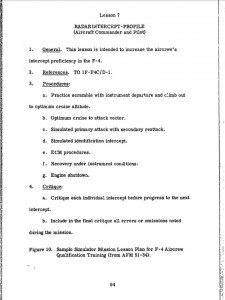
An F-4 Phantom simulator syllabus flight, easily replicated in modern home flight simulators. (Hall et al., 1967)
By 1979, the state of the F-4 simulator had progressed significantly enough that the Air Force commissioned studies into its effectiveness for air-to-air combat training. As usual, the Air Force spared no expense in its simulators, compare to the Marine Corps simulator described at the beginning:
“SAAC [Simulator for Air to Air Combat] is located at Luke AFB, Arizona, and is used for training air-to-air combat. It has two F-4 cockpits controlled by a common computer system which allows free air combat engagements between two pilots.
The visual system for each cockpit has a 296o horizontal by 150o vertical field of view. The visual scene is produced by a combination of a background scene and aircraft camera-model superimposition. The scene generated is displayed on Cathode Ray Tubes (CRTs) viewed through optical glass windows which provide continuity of the full visual field focused at infinity. The viewed area is monochromatic with a greenish cast. An analog system provides a representation of the earth, horizon, and sky. The earth representation consists of squares, ½ nautical mile on a side, displayed in four shades of gray. Each adjacent square is a different shade. Horizon appears as the top of a simulated haze band between the earth and the sky. The sky is homogeneous except for a sun image. While the brightness of the sun is not simulated, i.e. a pilot cannot hide in the sun, it can be used effectively for defense against heat-seeking missiles.”7
In Kelly, et al., 1979, the researchers sought to define measures of air combat maneuvering for one-versus-one free engagements in the SAAC. During the evaluation, participants fought against one another in the two linked F-4 simulators. Interestingly, because the researchers desired to have the participants fight dissimilar ACM against the MiG-21 and only the F-4 simulators were available, one of the F-4 simulators was configured to simulate the MiG-21:
“In addition, on the third day the two pilots considered to be the most experienced flew two additional sorties of three engagements in which one of the aircraft was programmed to have the same flight characteristics as a MiG-21. Each of these two pilots would fly one sortie in the F-4 configuration and one in the MiG configuration. These pilots all had prior experience with the MiG-21 dynamics on the SAAC.”8
A 1999 thesis for the Air Command and Staff College by Maj Keith A. Seaman investigated methods for improving F-15C air combat training with Distributed Mission Training (DMT) by comparing a number of previous studies of simulation effectiveness.9 One survey referenced was a 1990 examination of the McDonnell Aircraft (MACAIR) simulation facility in St. Louis, Missouri that evaluated the value of simulator training for F-15A/C unit-level training. The simulators used consisted of, “…two F-15 cockpits suspended in 40-foot domes providing pilots ‘with a nearly full field of view.’ Less sophisticated simulator cockpits were available for controlling interactive threats against the F-15 pilots.”10 The MACAIR study found many tasks were actually better trained in the simulator rather than in flight (see table). Continuing on the benefits of simulator training over in-flight training:
“Combining tasks into a realistic, complex scenario enhanced training. ‘Overwhelmingly, pilots thought the mission scenarios were the key ingredient to the training value…being challenging, demanding, realistic, and providing appropriate numbers of air threats for multibogey training.’ The ability to practice these scenarios numerous times were also found to be a unique benefit of the simulator training. ‘Pilots benefited greatly from repeated exposures to the same scenarios, and considered the variety of scenarios available in the simulator to be a major advantage…An especially important advantage of simulator-based training was the ability of immediate performance feedback that is not available in airborne training.’ Real-time kill removal allowed pilots to verify properly flown tactics, and see the consequences of poorly executed tactics or weapons employment.”11
One of the most significant advantages to training in the simulator versus in-flight training is the ability to simulate multiship operations in a complex environment. Continuing with Seaman’s thesis:
“Pilots surveyed during the MACAIR utility evaluations considered mission scenarios to be the ‘key ingredient to the training value’ of multiship simulator training. Similarly, DMT scenarios can be customized, allowing pilots to practice a wide variety of missions. Real-world airborne and surface-to-air threats will be selectable to provide realistic dissimilar air combat training not readily available in flight training.
Rigorous DMT scenarios can prepare pilots for complex training exercises such as Red Flag or Cope Thunder. This was demonstrated in a distributed mission simulation study involving A-10 aircraft conducting close air support missions. Practicing a Red Flag scenario in distributed simulators [prepared students for] dealing with the complicated communications and timing for multiple aircraft strikes. Even more importantly, DMT complex training should prepare pilots for actual combat.
DMT offers another unique feature of combat not possible in flight training: real-time kill removal. The MACAIR utility evaluations identified this as ‘an especially important advantage of simulator-based training.’ This capability is particularly helpful against multiple threats, allowing untargeted threats to be sorted after killed threats disappear.”12
This last point should not be trivialized. One of the more difficult challenges in any type of combat simulated in the real-world is separating “kills” from “live” players. In air-to-air combat this is frequently simulated by “killed” aircraft performing some type of maneuver (for example an aileron roll) at the merge. Typically, simulated kills must be arbitrated in some manner, usually by a “white cell” or other entity that adjudicates engagements. The artificiality of this method of simulating kills in real-world operations is clear as the surviving aircraft (or other entities) will still show killed aircraft on radar and will have to exercise some sort of suspension of disbelief to pretend the aircraft they clearly see on radar and/or visually is not there. In the simulated environment this limitation is overcome spectacularly, with killed aircraft disappearing, perhaps in smoke and flames.
Likewise, some air combat experiences like SAM avoidance cannot be adequately simulated in the real-world for obvious reasons. Other maneuvers such as low-level flight can be conducted in the real-world, but conducting realistic training in a high-threat environment is certainly safer in a simulated environment where pilots can push the envelope without the fear of death.
Tying it all Together
We started by asking the question, “How realistic are home flight simulators?” The answer to that question depends largely on the choice of simulation software, and how far one chooses to kit out their home “simpit” with high-end hardware. Clearly, though, the potential exists for home flight simulators that can be used in extremely realistic manner. In fact, the realism of the home simulation experience is likely largely limited by the ability and desire of the home civilian enthusiast.
Certainly the “study sim” of today is of much higher caliber, and provides a more realistic flight experience than the early simulators of the 60’s and 70’s. In almost all aspects the home simulator exceeds the early simulators’ capabilities. Graphically, military simulators didn’t approach the level of DCS or Microsoft Flight Simulator X until, probably, 2000 or so. Systems modeling in the early military simulators was likely very realistic to the real-world aircraft as evidenced by their recommended utility as procedures and instrument flight rules trainers. But this level of systems fidelity is realized in today’s study sims as evidenced by software like DCS: A-10 and Vertical Reality Simulations’ F/A-18E Superbug, a highly accurate simulation of the F/A-18E Super Hornet. Really, the only clear area where the 70’s simulators exceeded today’s home simulator is in the area of cockpit ergonomics; however with enough money today’s home simulator can be as close to the real thing as the hobbyist’s wallet and creativity will allow.
In many ways home simulators exceed military simulators. Up through the early-to-mid 2000’s Distributed Mission Operations was a concept still being fully developed. It is almost shocking that it took the military so long to develop this technology considering the existing civilian use of internet technology to connect simulators online. From the 70’s through the 2000’s much of military air-to-air flight simulation was (and still is) limited to local simulators connected with one another locally. And, U.S. military simulators are limited to “simulating” the flight envelope of non-U.S. aircraft using an existing U.S. simulator (for example, the F-4 simulating a MiG-21) or else they are forced to fly dissimilar ACM against another U.S. jet, like the linked F-15 and F-16 simulators used in the MACAIR study. Consider, then, the greater realism the home user has with the capability of flying an aircraft of DCS-quality like the forthcoming F/A-18C simulation against an opponent flying a faithfully represented MiG-21.DCS:
None of this should be taken as an assertion that someone who can fly an aircraft effectively in a home simulation is qualified to do it “for real.” There is no real cost-effective way to simulate the sensations of true flight in the home simulator. Even a simulator pilot with hundreds of hours in his home cockpit will feel sensory overload the first time the wheels come up in an actual aircraft. To pull Gs and maintain situational awareness in a real-world or simulated real-world flight in a modern fighter takes years of experience.
Yet, as has been demonstrated through research and many hobbyist’s first hand experiences is that flight simulation can provide useful, transferable skills that can be applied in real-world flight. Furthermore, the home simulator can provide a simulated combat experience that equals, or exceeds, the military’s capability through Distributed Mission Operations if conducted in a realistic manner. Indeed, it is almost mind-boggling the potential that exists now for the civilian hobbyist.
Really, the only limiting factor in all of this is the ability of the home hobbyist to have the desire to invest the time and effort to learn how to use these simulators effectively and realistically. As these simulators become more realistic, modeling systems and the environment at increasing levels of complexity, there is a much greater learning requirement in addition to a certain level of monetary investment in hardware. An aircraft like the F-16 or A-10 can’t really be effectively operated without a relatively expensive HOTAS system.
In closing, there has never been a better time to be a simmer than right now. If you’ve ever wondered how your home simming compares to “real life” you can rest assured that you either are experiencing, or can experience, something very close to what today’s military aviators do. Software under development by Eagle Dynamics, Benchmark Simulations, and Vertical Realty Simulations (among others) promise the potential to meet or exceed military simulation, especially in the multiplayer environment. Ultimately we as hobbyists are arriving at the point where home simulation offers as much realism as we can handle. It will be interesting to see if enough players will become interested in high-fidelity flight simulation to populate a multiplayer server with enough serious players to conduct realistic, civilian Distributed Mission Training. The day is nearly here. Will you step up to the challenge?
Recommendations
References
1. http://en.wikipedia.org/wiki/Falcon_4.0
2. Tirpak, J. A. 2005. Distributed Mission Operations. Air Force Magazine; 88:4. Available: http://www.airforcemag.com/MagazineArchive/Pages/2005/April%202005/0405mission.aspx
3. Hall, E. R., Parker Jr., J. F., and D. E. Meyer. 1967. A Study of Air Force Flight Simulator Programs. Air Force Systems Command, Wright-Patterson Air Force Base, OH.
4. Ibid.
5. Ibid.
6. Ibid.
7. Kelly, M. J., Wooldridge, L., Hennessy, R. T., Vreuls, D., Barnebey, S. F., Cotton, J. C., and J. C. Reed. 1979. Air Combat Maneuvering Performance Assessment. Naval Training Equipment Center, Orlando, FL; Air Force Human Resources Laboratory, Brooks AFB, TX.
8. Ibid.
9. Seaman, K.A. 1999. Improving F-15C Air Combat Training with Distributed Mission Training (DMT) Advanced Simulation. Air Command and Staff College, Maxwell AFB, AL.
10. Originally published in Houck, et al., Training Evaluation of the F-15 Advanced Air Combat Simulation. Referenced from Seaman, 1999.
11. Ibid.
12. Seaman


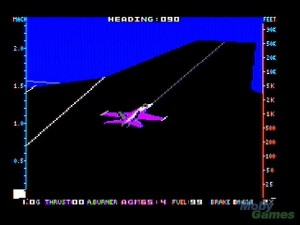
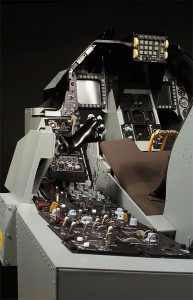
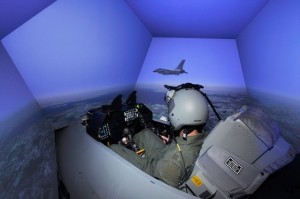

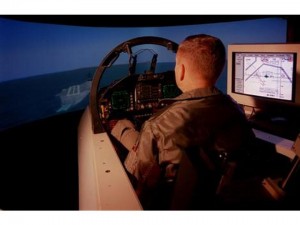
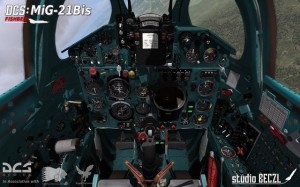

[…] Flight Sims – Just How Realistic Are They? | GrogHeads […]
[…] Flight Sims – Just How Realistic Are They? | GrogHeads […]
Born Color Blind DCS has been the only chance I was ever going to get to fly.
A very well done, and accurate piece. I was the AF crew chief of the SAAC simulator for several years at Luke AFB. Although the visual was all shades of green, in the heat of battle, you never noticed it.
Ingress and egress was done with the cockpit outside the visual dome, then the cockpits slid into the dome. Each cockpit had an instructor at the console. Usually, each instructor would only talk to his student pilot, but communication could be configured in several ways to talk to the pilots.
The models were plastic kits, painted bright green, mounted in a gimbal mechanism, with the image being transmitted to the visual on each cockpit. It was always exciting when, in the heat of battle, or one of the suspension wires, or fishing line, broke and the pilot saw his adversary dangling beside.
Often different flying squadrons would compete, which increased the competition, and bragging rights.